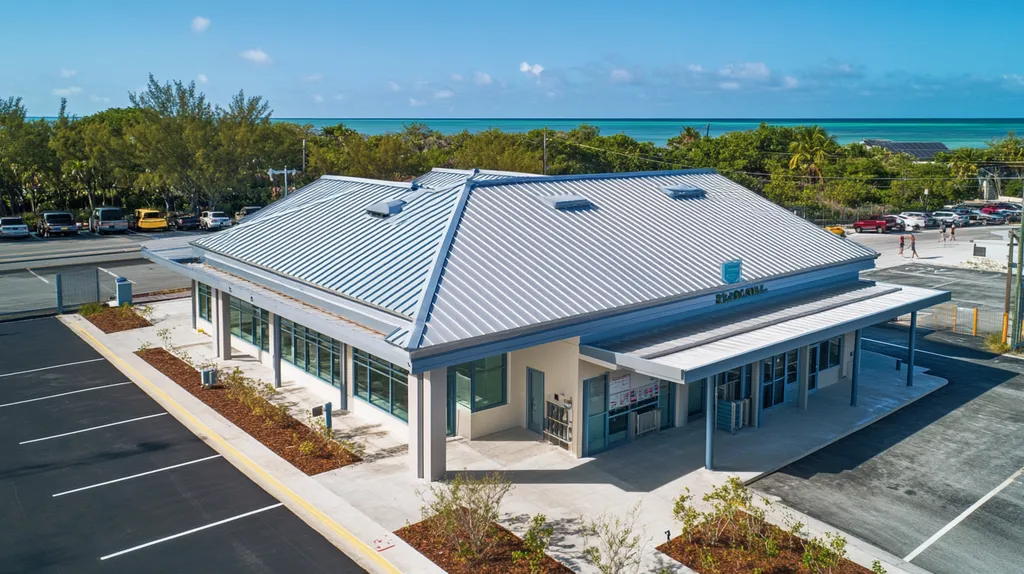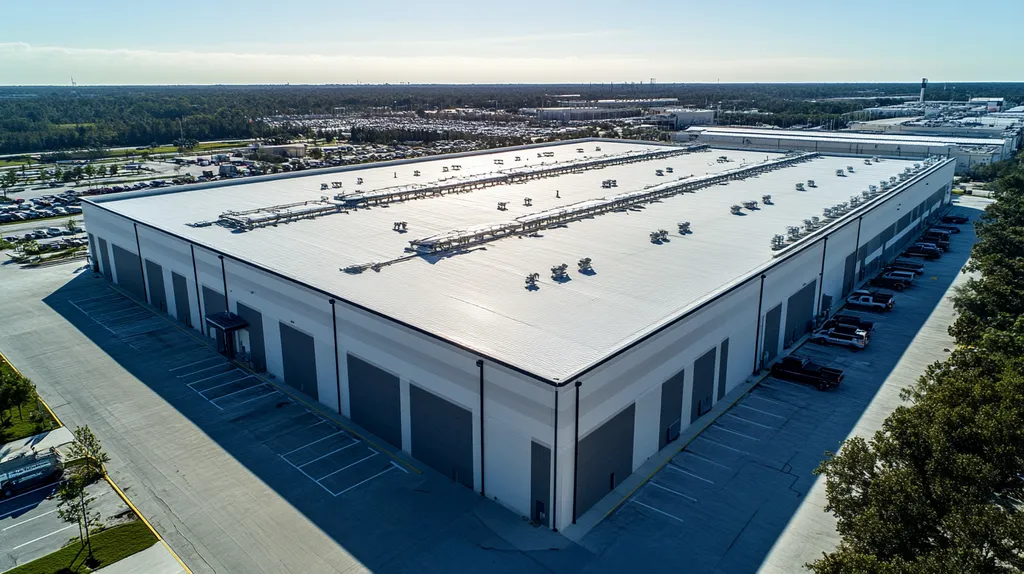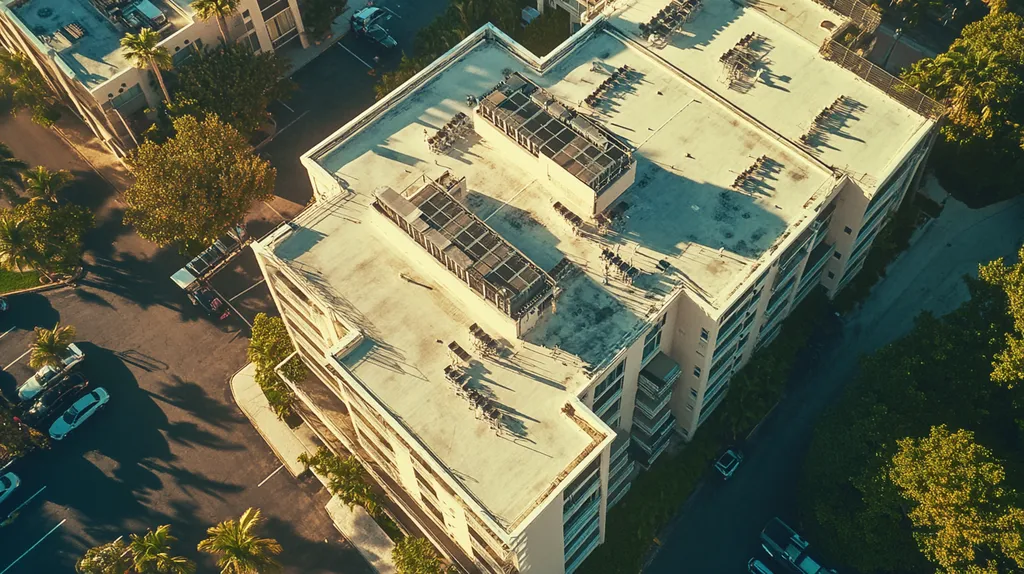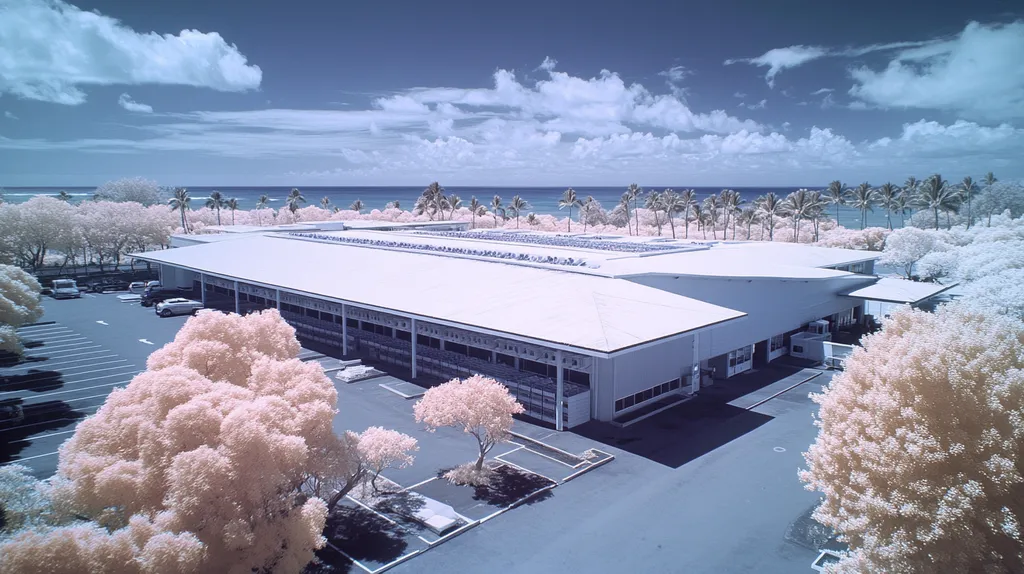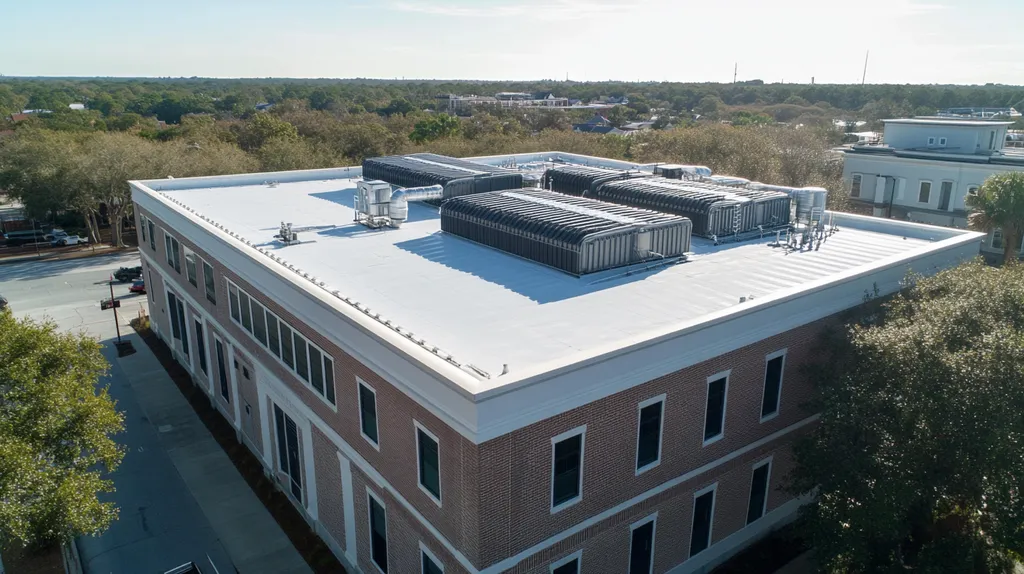Nearly 40% of commercial properties experience decreased valuation due to visually unappealing roofs, according to recent industry studies. Poor roof aesthetics not only impact property values but also signal potential structural issues to tenants and investors.
For property professionals, enhancing commercial roof aesthetics requires carefully balancing performance, compliance, and financial considerations. Modern roofing solutions offer unprecedented opportunities to improve visual appeal while boosting energy efficiency and durability.
This comprehensive guide examines critical factors in roof enhancement, from material selection and weather resistance to regulatory compliance and risk management strategies.
SECTION 1: PERFORMANCE FACTORS
Grasping the performance factors of a commercial roof is essential for property owners and facility managers. A roof that is visually appealing does more than enhance a building’s aesthetics; it also plays a key role in durability and energy efficiency. Poor material choices can result in expensive repairs and decreased property value. This section covers the vital considerations surrounding roof material selection, weather resistance, and energy efficiency assessments.
Roof Material Selection Strategies
Selecting the right roofing material is crucial in determining a building’s appeal, performance, and lifespan. Property professionals need to assess options that merge aesthetic and functional goals. For example, metal roofing not only offers a modern look but also provides long-lasting durability and requires minimal upkeep.
While traditional asphalt shingles may be suitable for some properties, they often can’t match the longevity of advanced materials such as TPO or EPDM. Recognizing the specific advantages and disadvantages of each roofing option empowers informed decision-making. Investing in higher-quality materials can elevate aesthetics and lower future repair costs.
In the end, a careful selection process enhances visual appeal and supports sustainable practices. Consider eco-friendly solutions like green roofs, which not only improve a building’s exterior but also align with environmental objectives.
Key Action Items
Weather Resistance Evaluation
Assessing weather resistance is vital for preserving a commercial roof’s structural integrity and visual appeal. Roofs must endure multiple weather elements, including harsh UV rays, heavy rainfall, and snow accumulation. Property managers should analyze the local climate when selecting their roofing materials.
For example, roofs in humid regions need materials that are resistant to mold and mildew, while roofs situated in snowy areas must efficiently handle ice and snow build-up. Choosing materials with high weather resistance reduces future maintenance needs and safeguards the building’s appearance over time.
Consider implementing reflective coatings, which can enhance both the roof’s visual appeal and its weather resistance. Ensuring your roof can withstand environmental challenges is crucial for maintaining long-term performance and value.
Key Action Items
Energy Efficiency Assessments
Energy efficiency is integral to the overall performance and visual appeal of a commercial roof. An energy-efficient and well-insulated roof can lead to significant savings on heating and cooling bills, positively impacting the property’s finances. Property owners should explore options like reflective or cool roofing materials to boost energy efficiency.
For example, roofs with light-colored surfaces can reflect solar heat, which lessens energy consumption. This not only lowers operational costs but also adds to the property’s aesthetic allure, often resulting in higher tenant satisfaction.
Incorporating energy-efficient features can enhance sustainability credentials, an increasingly vital factor in today’s property market. An energy-efficient roof serves both practical and aesthetic needs, aligning with current standards and expectations.
Key Action Items
SECTION 2: FINANCIAL CONSIDERATIONS
Financial considerations are crucial when enhancing the visual appeal of a commercial roof. A beautifully designed roof not only boosts property value but also prevents costly long-term repairs. Research indicates that properties with attractive roofs can see a value increase of up to 10%. Therefore, property owners and facility managers must thoroughly evaluate the financial implications of any roofing improvements.
Cost-Benefit Analysis Techniques
Conducting a cost-benefit analysis is vital for understanding potential roofing upgrades. Property owners should start by identifying the initial expenses, which include materials and labor for aesthetic enhancements. Next, they need to weigh these costs against the benefits, such as improved energy efficiency and a more visually appealing building.
For instance, transitioning to a reflective roofing system can drastically reduce energy costs, leading to substantial long-term savings. By calculating the payback period, property managers can better assess the financial feasibility of these enhancements. This analysis empowers stakeholders to make strategic decisions that align with their financial goals.
A thorough cost-benefit analysis ensures that property owners focus on improvements that yield the best returns without sacrificing aesthetics. This structured approach allows them to maximize their investment effectively.
Key Action Items
Budgeting for Aesthetic Improvements
Robust budgeting is essential for any roofing project aimed at enhancing aesthetics. Property professionals must first evaluate the current roof’s condition and identify necessary upgrades. This process will clarify what improvements are needed and estimate their costs.
Involving stakeholders in budgeting ensures realistic timelines and effective financial planning. For example, bundling multiple improvement projects could lead to savings through bulk purchases or lower labor costs.
Systematic fund allocation mitigates financial strain while achieving desired visual outcomes. A well-structured budget clarifies project priorities and safeguards against unexpected expenses during execution.
Key Action Items
Return on Investment Calculations
Calculating the return on investment (ROI) for aesthetic roofing improvements is essential for demonstrating their value. This calculation compares enhancement costs to the expected increase in property value or rental income, offering a clear picture of financial benefits.
As an example, if a new roof installation costs $100,000 and leads to a $150,000 increase in property value, the ROI would be 50%. Such analyses empower property owners to make informed decisions about where to invest their resources effectively.
Incorporating ROI metrics into financial planning strengthens the justification for roofing projects focused on aesthetics, ensuring stakeholders can visualize long-term gains and act on them proactively.
Key Action Items
SECTION 3: COMPLIANCE REQUIREMENTS
Compliance requirements are crucial for successfully enhancing the visual appeal of commercial roofs. Neglecting these regulations can lead to hefty fines, project delays, and lasting damage to a property’s reputation. For example, nearly 30% of commercial projects experience delays due to overlooked zoning regulations. By proactively addressing building codes, environmental requirements, and zoning ordinances, property professionals can streamline their roofing enhancement efforts.
Building Code Adherence Guidelines
Building codes establish essential construction standards that ensure both safety and structural integrity. Property owners must become familiar with local building codes, as these can differ significantly from one area to another. Ignoring these codes can result in steep penalties and prolonged project timelines.
Many municipalities impose specific requirements for materials and installation methods that can directly affect a roof’s aesthetics. Utilizing resources such as municipal websites or local building offices can immensely clarify these important guidelines.
Engaging licensed roofing professionals is essential, as they understand how to navigate applicable codes. This collaboration helps guarantee that roofing upgrades not only comply with legal standards but also enhance the property’s overall appearance.
Key Action Items
Environmental Regulation Compliance
Environmental regulations are designed to protect natural resources during construction and renovation projects. It is vital for property owners to comply with these rules, especially when it comes to roofing materials. For instance, restrictions on materials that emit harmful substances are common in many jurisdictions.
Property owners should assess roof coatings and materials for their environmental impact. By choosing eco-friendly materials, they not only stay compliant but also elevate the building’s aesthetics with modern and sustainable options.
Failure to adhere to environmental regulations can lead to serious consequences, including significant fines and negative public perceptions of the property. Furthermore, adopting sustainable practices can attract tenants who prioritize eco-friendly buildings, thereby increasing property value.
Key Action Items
Zoning Ordinance Considerations
Zoning ordinances dictate land use and can significantly influence the visual aspects of roofing projects. These regulations specify what types of modifications can occur and establish limits on building size and visibility, affecting the overall aesthetics.
Understanding these ordinances is essential for property owners who aim to enhance their roofs effectively. For instance, height restrictions or visibility concerns can limit design options based on local rules.
Engaging proactively with local zoning boards can clarify the potential for enhancements within these guidelines. This interaction may reveal creative opportunities that not only comply with regulations but also improve visual appeal.
Key Action Items
SECTION 4: RISK MANAGEMENT
Managing risks related to commercial roofing is essential for ensuring both aesthetic appeal and structural integrity. It’s alarming that over 40% of roofing systems fail prematurely due to unresolved issues, highlighting the need for property professionals to take proactive measures. Effectively identifying potential hazards, utilizing robust assessment tools, and planning comprehensive mitigation strategies safeguard property investments while enhancing roof aesthetics.
Hazard Identification Procedures
Systematic hazard identification serves as the foundation for effective risk management on commercial roofs. Regular inspections are key to uncovering problems such as membrane degradation, poor drainage, and structural flaws. Checklists that target common roof issues can simplify this vital process.
Collaborating with experienced roofing professionals strengthens hazard identification efforts, as they can detect hidden issues that property owners might overlook. Additionally, maintaining records of previous inspections and repairs helps recognize recurring problems over time.
Technology also significantly enhances hazard identification. Advanced drone inspections can swiftly assess roof conditions, offering a comprehensive view from multiple perspectives. These drones can pinpoint moisture accumulation and surface damage that may not be perceptible from the ground.
Key Action Items
Risk Assessment Tools and Techniques
After hazards are pinpointed, utilizing risk assessment tools is essential for evaluating their potential impacts. Techniques like Failure Mode and Effects Analysis (FMEA) help property managers prioritize risks according to severity and likelihood, allowing for immediate attention on critical issues.
Risk heat mapping is another effective tool that visually highlights hazards on a roof. This method helps property professionals easily identify high-risk areas needing focused interventions, simplifying the decision-making process.
Moreover, enlisting third-party consultants for risk assessments provides an impartial perspective on vulnerabilities. Their expert evaluations typically include tailored recommendations based on the specific building type and local conditions.
Key Action Items
Mitigation Strategy Planning
Planning effective mitigation strategies is crucial for addressing identified risks and elevating roof aesthetics. Property managers should establish comprehensive maintenance schedules that incorporate routine inspections. Ongoing upkeep can help identify and solve issues before they evolve into costly damages.
Investing in high-quality roofing materials is another proactive measure to mitigate future risks. Selecting durable and visually appealing materials, like reflective membranes, can enhance a roof’s appearance while also reducing energy expenses.
Establishing a clear communication plan ensures all stakeholders are informed about maintenance processes and updates to risk management strategies. Regular updates on roof conditions emphasize shared responsibility between property managers, staff, and contractors.
Key Action Items
SECTION 5: OPERATIONAL PROCEDURES
Adopting robust operational procedures is vital for preserving the visual integrity of a commercial roof. Neglecting these practices can lead to quick deterioration, resulting in expensive repairs and diminished appeal. Studies show that with regular maintenance, roofs can last up to 25% longer. Implementing systematic maintenance schedules, detailed inspections, and effective project management ensures that roofs remain both attractive and functional.
Maintenance Scheduling Best Practices
Creating a consistent maintenance schedule is foundational to keeping a commercial roof looking its best. Many property managers underestimate this crucial task, allowing minor problems to snowball into major issues. A proactive maintenance plan should incorporate seasonal inspections and periodic cleanings to eliminate debris and prevent buildup.
Best practices suggest inspecting roofs at least twice a year—in spring and fall—to catch potential leaks or structural damage early. Additionally, maintaining detailed records of all maintenance activities can provide valuable insights over time.
Utilizing a maintenance management system can streamline these processes, ensuring nothing slips through the cracks. Investing in regular maintenance helps extend the roof’s lifespan while ensuring the property maintains its visual appeal and market value.
Key Action Items
Inspection and Repair Protocols
Conducting regular inspections is essential for retaining aesthetic appeal, as they unveil potential issues before they escalate. Inspections should be scheduled during maintenance visits and performed by trained professionals knowledgeable in identifying damage, leaks, and wear on roofing materials.
Prompt repairs are crucial; small fixes, like sealing cracks or replacing missing shingles, prevent larger damages down the line. Overlooking necessary repairs not only impacts appearance but can also threaten the roof’s structural integrity.
Implementing a solid protocol for documenting and addressing issues enhances inspection effectiveness. Keeping thorough records of findings and actions taken aids future inspections and helps maintain overall roof health.
Key Action Items
Project Management Techniques
Efficient project management plays a pivotal role in executing roof enhancement projects successfully. Property managers need to establish clear timelines, budgets, and scopes, which help maintain control over the process and reduce risks of overspending.
Clear communication with contractors fosters collaboration, allowing for prompt adjustments and ensuring everyone is aligned on expectations. Implementing a feedback loop among stakeholders facilitates quick identification and resolution of challenges.
When making changes, thoughtful incorporation of design elements is essential. Selecting colors and textures that complement the building’s architecture can significantly boost visual interest. Tracking project progress through structured reports allows for constant evaluation of both aesthetics and functionality.
Key Action Items
SECTION 5: OPERATIONAL PROCEDURES
Effective operational procedures are essential for maintaining the visual integrity of a commercial roof. Without a structured approach, roofs can deteriorate quickly, resulting in costly repairs and an unappealing appearance. Research indicates that consistent maintenance can extend roof life by as much as 25%. Implementing systematic maintenance schedules, thorough inspections, and strong project management ensures that roofs remain visually striking and functional.
Maintenance Scheduling Best Practices
Establishing a regular maintenance schedule is vital for keeping a commercial roof looking its best. Many property managers underestimate this step, allowing minor issues to escalate into significant problems. A proactive maintenance plan should include seasonal inspections and routine cleanings to remove debris and prevent buildup.
Best practices recommend scheduling inspections at least twice a year—in spring and fall. This approach enables early identification of potential issues, such as leaks or structural damage. Additionally, property owners should maintain detailed records of all maintenance activities and findings.
Utilizing a maintenance management system can simplify the scheduling and tracking process to ensure that critical issues do not go unnoticed, preserving both roof integrity and aesthetics. Timely maintenance protects property values by enhancing overall building appeal.
Key Action Items
Inspection and Repair Protocols
Routine inspections are critical for maintaining roof aesthetics and functionality. These assessments should occur during maintenance visits and be conducted by trained professionals capable of identifying damage, leaks, and wear on roofing materials.
Immediate repairs must be prioritized following inspections. Small fixes, such as sealing cracks or replacing missing shingles, can prevent larger, more costly problems in the future. Ignoring necessary repairs can compromise both appearance and structural integrity.
Establishing a clear protocol for documenting and addressing concerns enhances the effectiveness of inspection efforts. Thorough records of findings and repairs aid future evaluations and help ensure ongoing roof health.
Key Action Items
Project Management Techniques
Effective project management is critical during roof improvement initiatives. Property managers should define clear project timelines, budgets, and scopes to maintain control over the process and reduce any risk of overspending.
Regular communication with contractors fosters collaboration, enabling quick adjustments as needed. This teamwork ensures everyone stays aligned on expectations, resulting in a smoother project flow. Implementing a feedback loop with all stakeholders helps identify problems early on, facilitating faster resolutions.
Moreover, thoughtfully incorporating design elements during repairs or replacements is essential. Selecting colors and textures that complement the building’s architecture can significantly elevate visual appeal. Monitoring the project’s progress through structured reports ensures aesthetic goals remain a top priority.
Key Action Items
Looking Ahead
With 40% of commercial properties experiencing decreased valuation due to poor roof aesthetics, the stakes for property professionals have never been higher.
The convergence of performance requirements, financial considerations, and compliance standards demands a comprehensive approach to roof enhancement initiatives.
Industry data shows that properties implementing strategic aesthetic improvements see up to 15% higher occupancy rates and command premium lease rates.
Success requires careful material selection, rigorous maintenance protocols, and strict adherence to building codes and environmental regulations.
By following established best practices and leveraging emerging technologies, property managers can transform their roofs from mere functional assets into valuable architectural features that drive property performance and value appreciation.
FREQUENTLY ASKED QUESTIONS
Q. What performance factors affect a commercial roof’s appeal?
A. Performance factors include material selection, weather resistance, and energy efficiency. These elements directly impact the roof’s durability and visual appeal, ensuring long-term benefits.
Q. How can a commercial roof enhancement increase property value?
A. Aesthetic enhancements can lead to value increases by boosting curb appeal, attracting tenants, and reducing maintenance costs. An appealing roof typically enhances overall property marketability.
Q. What compliance requirements should I know for my industrial roof?
A. Important compliance requirements include building codes, environmental regulations, and zoning ordinances. Understanding these regulations is essential to avoid penalties and ensure successful roof enhancements.
Q. How can I identify hazards on my commercial roof?
A. Regular inspections and utilizing checklists can help identify hazards. Collaborating with experienced roofing professionals and using technology like drones enhances hazard detection efficiency.
Q. What are the best practices for maintaining a commercial roof?
A. Best practices include scheduling semi-annual inspections, documenting maintenance activities, and establishing routine cleaning. These steps help prolong roof life and maintain its aesthetic appeal.
Q. What project management techniques are effective for roof enhancements?
A. Effective techniques involve defining clear timelines and budgets, fostering communication with contractors, and ensuring stakeholder feedback. This approach helps manage projects smoothly and meet aesthetic goals.
Q. How do I choose the right aesthetic features for my commercial roof?
A. Consider the architectural style of your building, the local climate, and energy efficiency options. Selecting materials and colors that complement the structure can enhance visual interest and appeal.

